The ultimate goal of Experience Management (XM) is to design and improve people’s experiences. However, experiences are inherently personal. What constitutes a “good” experience for one person may not be a good experience for another. Every person has their own individual needs, desires, motivations, goals, and beliefs, and this unique lens colors how they perceive their experiences. So before an organization can design engaging experiences, it first needs to clearly identify the people it is designing for.
One of the most valuable tools organizations can create to document and share information about their target audiences is a persona. A persona refers to:
A vivid description of a prototypical person within a specific segment.
The value of a persona is that it creates a common understanding of a specific audience within the group of people who are responsible for designing or improving experiences for that audience.
Personas are usually created to support a specific project – like a journey mapping exercise, a human-centered design process, or a marketing campaign – though their influence will sometimes extend more broadly across the organization  . Regardless of their exact application, well-crafted personas allow a team to:
. Regardless of their exact application, well-crafted personas allow a team to:
- Bring traditional segmentation models to life. While many organizations already have some traditional customer or employee segmentation in place, these segments tend to be built around demographic information, such as age, income, and gender. These attributes, however, are often not the defining characteristics that shape people’s perceptions of their experiences. Other traits – like goals, attitudes, skills, motivations, values, habits, fears, and personality – are usually more relevant to how people interpret and respond to experiences. Yet these existing, demographically focused segmentation models can still provide value. Organizations should use these traditional models to target the right groups of customers or employees by developing personas that map into these segments
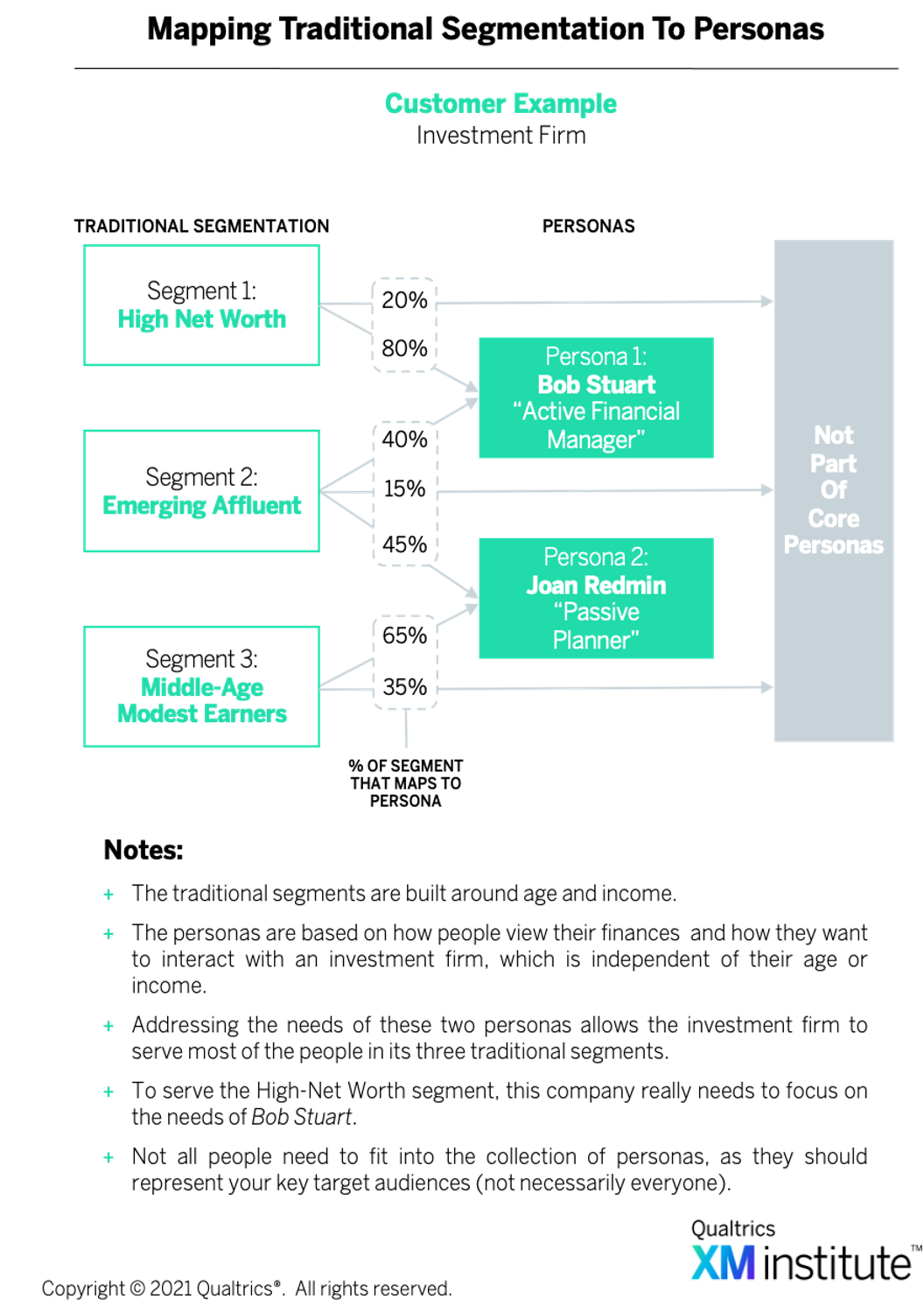 .
. - Capture and communicate research findings. Although personas are depicted as a single individual, they are actually the distillation of research from a number of different people within a specific segment. They allow organizations to summarize and share a substantial amount of quantitative and qualitative data in the form of a limited number of compelling characters and stories, which people inherently internalize and remember better than reports with disconnected data points.
- Generate empathy for the people consuming experiences. Personas are a particularly helpful tool for building empathy inside the organization. Human beings are naturally disposed to empathize with other people on an individual basis, but we struggle to scale that compassion up to large groups. So rather than asking people to empathize with nameless masses of customers, employees, or partners – most of whom they will never meet – personas give these groups a few memorable faces and stories.
- Design for a specific audience. Personas are also crucial for sharpening people’s focus on target users during the design process. Trying to create experiences for an amorphous, ill-defined audience will only lead to compromises, inconsistencies, and self-referential designs that appeal to the people creating the experience more than to the people consuming it. Personas are critical for the design process as they bring the target audience to life, establish a common understanding of who this group is, and help the design team make tradeoffs and prioritization decisions.
- Build organizational alignment. Personas create a common frame of reference and vocabulary that’s shared by individuals and groups across the organization. When everyone shares a universal, research-backed understanding of who the target audience is and how they are likely to feel and behave as they engage with the organization, it makes it easier to build cross-functional consensus and resolve internal conflicts. It also makes communication between individuals and teams more efficient because they can use shorthand to discuss the audience’s needs, challenges, and characteristics.
Elements of a Good Persona Document
While a persona usually manifests as a simple document, the document itself is not the persona. A persona is a shared conception of who the organization’s key customer or employee groups are, whereas persona documents showcase the attributes of that group that are most relevant to a specific design project. Consequently, there is no single “right” way to create a persona document. There is a universe of potential characteristics and elements you could include, and which ones you choose will depend entirely on the needs and goals of the particular project you’re creating the personas to support.
The guiding principle here should be to select attributes that will allow the people using the personas to understand and adopt the perspective of their target design audience, so they can accurately anticipate how members of this group are likely to think, feel, and behave during a given experience. Here are some elements that we commonly find in well-crafted personas documents 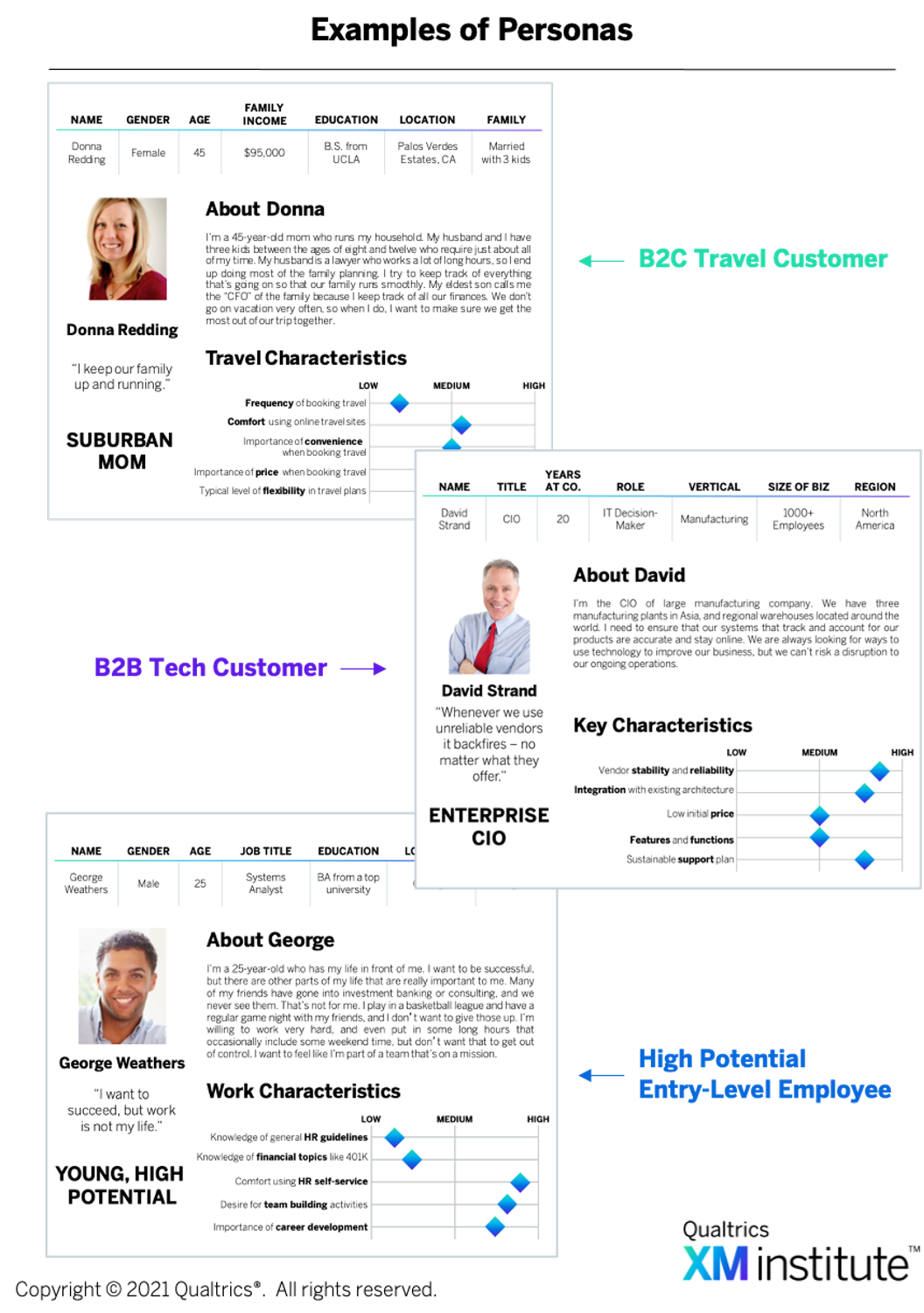 :
:
- Segment title. Persona documents often also contain a short, descriptive title that identifies which segment the persona represents. This title will help people connect the persona to segments they may be more used to hearing about from a business or strategy perspective. For example, a customer persona may represent the “Suburban Mom” or the “Active Business Traveler” segment, while a B2B persona may embody the “Enterprise CEO” or the “Marketing Operations Manager” segment, and an employee persona may depict the “Experienced New Hire” or “Newly Promoted People Manager” segment.
- Name. Each persona should have a first and last name that is appropriate given their demographic information. Rather than give personas a cartoonish name like “Annie Accountant” or “Frankie Frequent Flier” – which will make it harder for people using the personas to take them seriously – give them a name that sounds like a real person. It’s also important to ensure that these names do not support any biases or stereotypes.
- Demographic information. Most persona documents include some limited demographic information to help paint a more vivid picture of who this person is and what expectations they are likely to bring into interactions. For example, in a customer persona you may include information like location, age, gender, educational level, income, family composition/marital status, products owned, and where they are in the customer lifecycle. Meanwhile, for B2B personas, this description may cover characteristics like job title, years at their company, role, department, size of business, industry, and region. Employee personas, on the other hand, often show attributes such as role, region, department, tenure, education, salary scale, responsibilities, and age.
- Persona story. One of the most essential elements of any well-crafted persona document is a rich description of who this person is. While the exact form of this description can take many different shapes – such as a day-in-the-life narrative, a profile, or just a straightforward summary – the goal here is to tell a story that is relevant to the specific purpose and application of the persona. The more realistic you can make this story, the more persona users will be able to empathize with people in this segment and predict how they are likely to feel and behave as they engage with the organization.
- Indicative quote. Another common component of the document that will help you flesh out the persona is an indicative quote that neatly encapsulates this character’s story in a single sentence. This quote should be written from the perspective of the persona and should sound like something a person who matches the persona’s description would say. For example, the “Suburban Mom” customer persona’s quote might be, “I keep our family up and running.” The one for the Enterprise CIO B2B persona, on the other hand, may say, “Whenever we use unreliable vendors it backfires – no matter what they offer,” while the indicative quote for the Junior Marketing Associate employee persona may be, “I can’t wait to begin building a career out of my passion for social media!”
- Key characteristics. This section is often the richest element of a persona document. Here is where you spotlight five to seven traits of individuals within this particular group. These traits should not only reflect the defining characteristics of people in this group that shape their behaviors and perceptions of success, effort, and emotion as they interact with the organization, they also need to link the personas to the objectives of the design project and meaningfully distinguish them from individuals in other segments. For example, if all customers are concerned about price or all employees are concerned about salary, these should not be included as key characteristics. Which traits you do include will depend entirely on the needs of the project team and organization. Regardless of the specific characteristics, they should always be derived from target audience research, not gut instincts
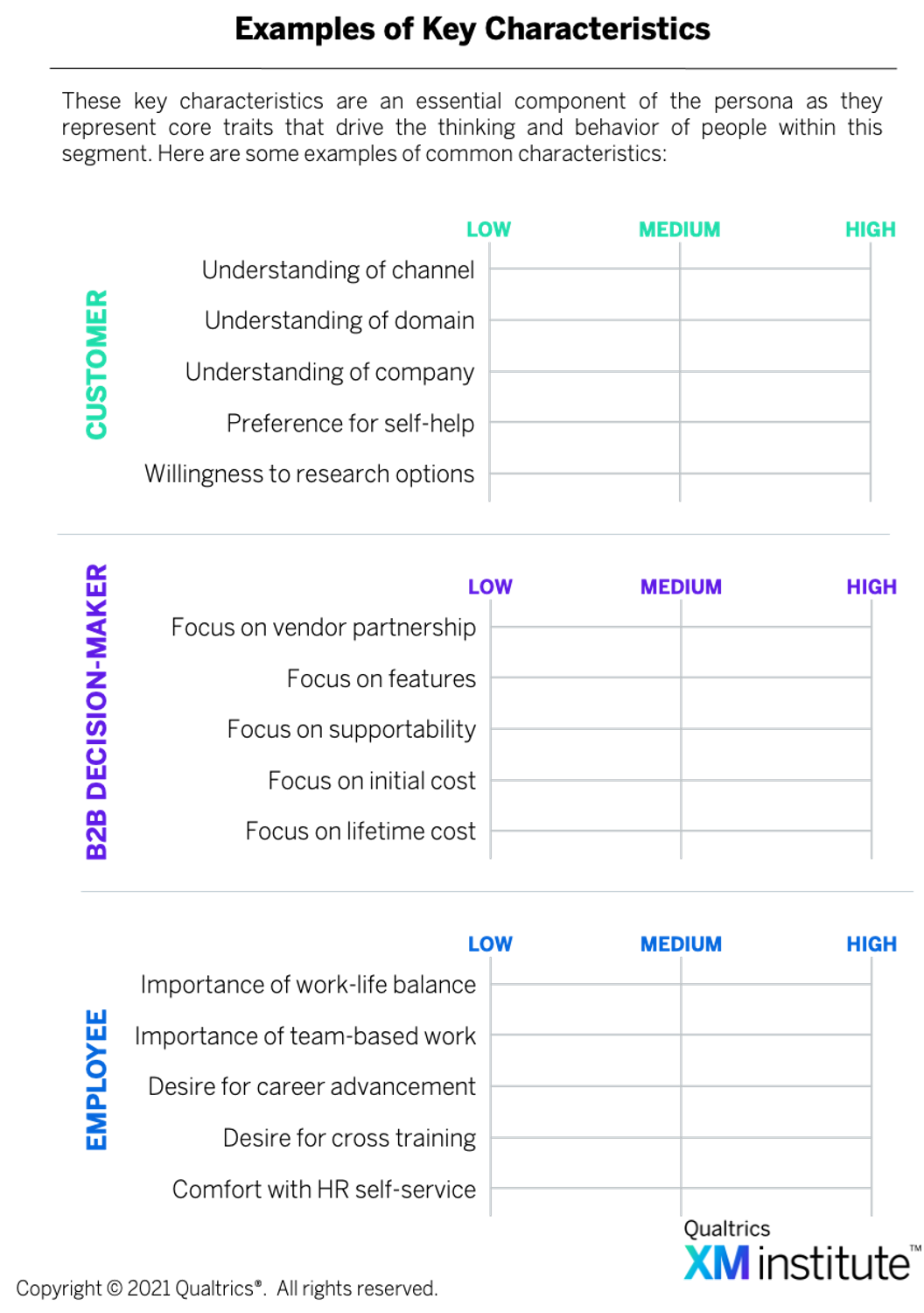 .
. - Photo. Adding a picture to the document will give your persona a distinct visual identity and make it come alive in the minds of the persona users in a way that no descriptive text ever could. The photo you include should be polished and professional looking and should match the demographic information provided. A free stock photo is fine, as long as it’s high-quality and doesn’t appear too staged.
The Five Phases of Building a Persona
The exact path you take to build a persona will depend on a number of different factors, including the needs and goals of your project, how widely (if at all) the personas will be shared, and whether personas already exist in some form across the business. However, we have identified five phases that teams generally flow through as they develop personas  :
:
- Phase 1: Preparation. To keep the team aligned and focused throughout the entire persona development process, you first need to define an overarching vision and strategy for this effort, articulating why it’s a worthwhile endeavor and how you expect to achieve your objectives.
- Phase 2: Research. Strong personas are grounded in a thorough understanding of the people within target groups and their existing experiences with the organization. To develop this deep understanding, tap into a wide variety of different data sources, including existing survey results, interviews with internal experts, and – most importantly – in-depth qualitative research.
- Phase 3: Analysis. Once you’ve completed your research, you then need to translate the raw data you collected into three-dimensional archetypes by organizing and analyzing your findings to uncover underlying patterns and relationships.
- Phase 4: Creation. You will then produce a collection of robust persona documents that effectively communicate the significant attributes of your target audience in a way that’s easy for people using these artifacts to internalize and apply.
- Phase 5: Deployment. Finally, personas are only valuable when they are used. So after you have built a set of personas, you need to leverage them to inform the design and development of products, services, and experiences.
Phase 1: Preparation
As we’ve reiterated numerous times throughout this report, personas can take many different forms and be put to many different uses. While this flexibility is part of what makes personas such valuable tools, it also means that without proper planning, they can quickly devolve into an unwieldy, never-ending sinkhole of time and resources. The ultimate quality of your personas will heavily depend on how well you lay the groundwork for this effort, outlining – and then executing – a well-defined strategy for bringing these personas to life. Here are the steps you should follow within the Preparation Phase:
- Define a clear purpose. Before you begin conducting research or analyzing insights, you first need to define the purpose of your personas. Clarifying why you are building these artifacts is an important first step because this purpose will act as a North Star throughout the rest of the development process, guiding all decisions and keeping everyone aligned and on track throughout the journey so you reach your end goal as efficiently and painlessly as possible. And once you reach your end goal, having a clear purpose will help you track and communicate the value of these artifacts to relevant stakeholders across the organization. The exact scope of this step will vary dramatically depending on whether personas are a common tool for your team or project – like UX design, journey mapping, or product development – or a relatively novel activity.
- Identify your target audience. After determining the purpose of your personas, you need to further refine the scope of this project by identifying which groups of customers or employees you plan on building personas around and which journeys you want to focus on. This decision should reflect the stated goals of your project as well as any relevant business and brand objectives, like which groups interact with the organization the most, which groups generate the most value, which new markets the company is expanding into, which groups are the most complicated to serve, or which journeys are the most broken. How exactly you decide to categorize these groups – whether it’s by demographics, psychographics, behavior, goals, etc. – will also depend on these project and organizational objectives
 . In some instances, you may only want to focus on a single group. The decisions you make in this step are enormously consequential because they will affect both your research strategy and how you organize and interpret your findings.
. In some instances, you may only want to focus on a single group. The decisions you make in this step are enormously consequential because they will affect both your research strategy and how you organize and interpret your findings. - Develop your approach. Next, you need to develop a strategy and roadmap for bringing personas to life. Again, the length and output of this step will vary depending on the scope of your project, but you should at least create a basic plan that outlines expected timelines, key milestones, deliverables, responsibilities, and measures of success. It should also include the vision and goals you identified above. For more expansive projects, this step might extend to establishing a core team to lead the development effort as well as cross-functional governance structures to get work done across the organization.
Phase 2: Research
Once you’ve laid the necessary groundwork for your persona project, you then need to generate or assemble the data that will shape these artifacts. Which data sources you plumb and which research methods you use will, once again, depend on your project’s scope and strategy. However, regardless of your exact approach, the goal throughout this phase should be to establish a thorough understanding of the people who make up your target groups. Here are the steps you should follow within the Research Phase:
- Compile existing data points. In all likelihood, your organization has already captured data in some form on people within your target groups. So rather than start your research efforts from scratch, take the time to compile relevant insights from sources across the organization. The best personas incorporate information from a variety of different sources, such as survey results, focus groups, external studies, operational data (O-data) from existing enterprise applications like CRM and HR, as well as unstructured data from places like contact center or help desk notes, product reviews, or social media posts
 . Taking the time to surface these insights will not only help you understand the current state of your target audience’s experiences with the organization, it will also allow you to formulate a more focused strategy for who to talk to and what to ask during your qualitative research.
. Taking the time to surface these insights will not only help you understand the current state of your target audience’s experiences with the organization, it will also allow you to formulate a more focused strategy for who to talk to and what to ask during your qualitative research. - Conduct qualitative research. While existing insights can provide valuable context around people’s current experiences, conducting your own in-depth qualitative research is essential for creating substantive, realistic personas
 . Here you should be interviewing and/or observing eight to 20 individuals who fit within your target groups with the goal of generating a deep understanding of their needs, goals, desires, motivations, and challenges. Because this research will form the bulk of the input into the persona elements, the exact dimensions you focus on here – who you talk to, which questions you ask, which characteristics and activities you investigate – need to reflect the purpose and application of your personas.
. Here you should be interviewing and/or observing eight to 20 individuals who fit within your target groups with the goal of generating a deep understanding of their needs, goals, desires, motivations, and challenges. Because this research will form the bulk of the input into the persona elements, the exact dimensions you focus on here – who you talk to, which questions you ask, which characteristics and activities you investigate – need to reflect the purpose and application of your personas. - Interview internal SMEs. In addition to capturing information directly from members of your target audience, you can also solicit input from cross-functional Subject Matter Experts (SMEs) who have insights into the relevant journeys of your key groups. These internal experts can provide deeper context around crucial pieces of your target audience’s experiences and help validate your qualitative research findings and interpret the information you’ve collected. You may also find that groups across your organization like marketing, UX departments, HR, or people analytics already use some type of persona or segmentation model, which you can borrow and update to suit the needs of your particular project.
Phase 3: Analysis
After you’ve thoroughly researched the people within your target groups, it’s time to interpret and analyze the data you’ve amassed. The goal of this phase is to convert this raw data into meaningful insights and then transform those insights into realistic archetypes, which will ultimately become your personas. People are multidimensional and complicated, which means that which characteristics and patterns you choose to concentrate on – and which methods you use to uncover these themes – is heavily dependent on your individual project. Here are the steps you should follow within the Analysis Phase:
- Translate data into insights. It is incredibly difficult to tease out underlying themes and relationships from raw data that comes from different places and lives in different forms. So before you begin to interpret your research findings in earnest, you first need to translate the unprocessed data you’ve collected into usable insights. You do this by combing through your research findings and pulling out relevant, consequential information that reveals something meaningful about either your target audience, the journey you’re focused on, or your broader organization, industry, or market. These snippets of information may be expressed in a number of different ways, such as direct quotes from interviews or survey verbatims, meaningful percentages or numbers, or just observations about people’s behaviors, attributes, or motivations. Depending on the process you intend to follow to uncover themes and patterns, you might add these insights to individual post-it notes, write them out in interview summaries, or enter them into an Excel spreadsheet. Regardless of the method, make sure these insights are easily linked back to their original sources.
- Identify clusters and patterns. Once you have extracted a collection of insights from your raw data, you can begin to analyze and organize your findings. While the first step here should be to map these insights across the target groups you defined in the Preparation Phase (if you are in fact focusing on multiple groups), that’s only the initial, high-level sorting exercise. Just because people are part of the same broad group – like new hires or Millennials – doesn’t mean they align on other key factors that influence their experiences. The richness and value of personas really comes from the next step, where you organize your insights within each group, identifying smaller clusters and patterns of attributes that affect how people will think, feel, and behave during their relevant experiences
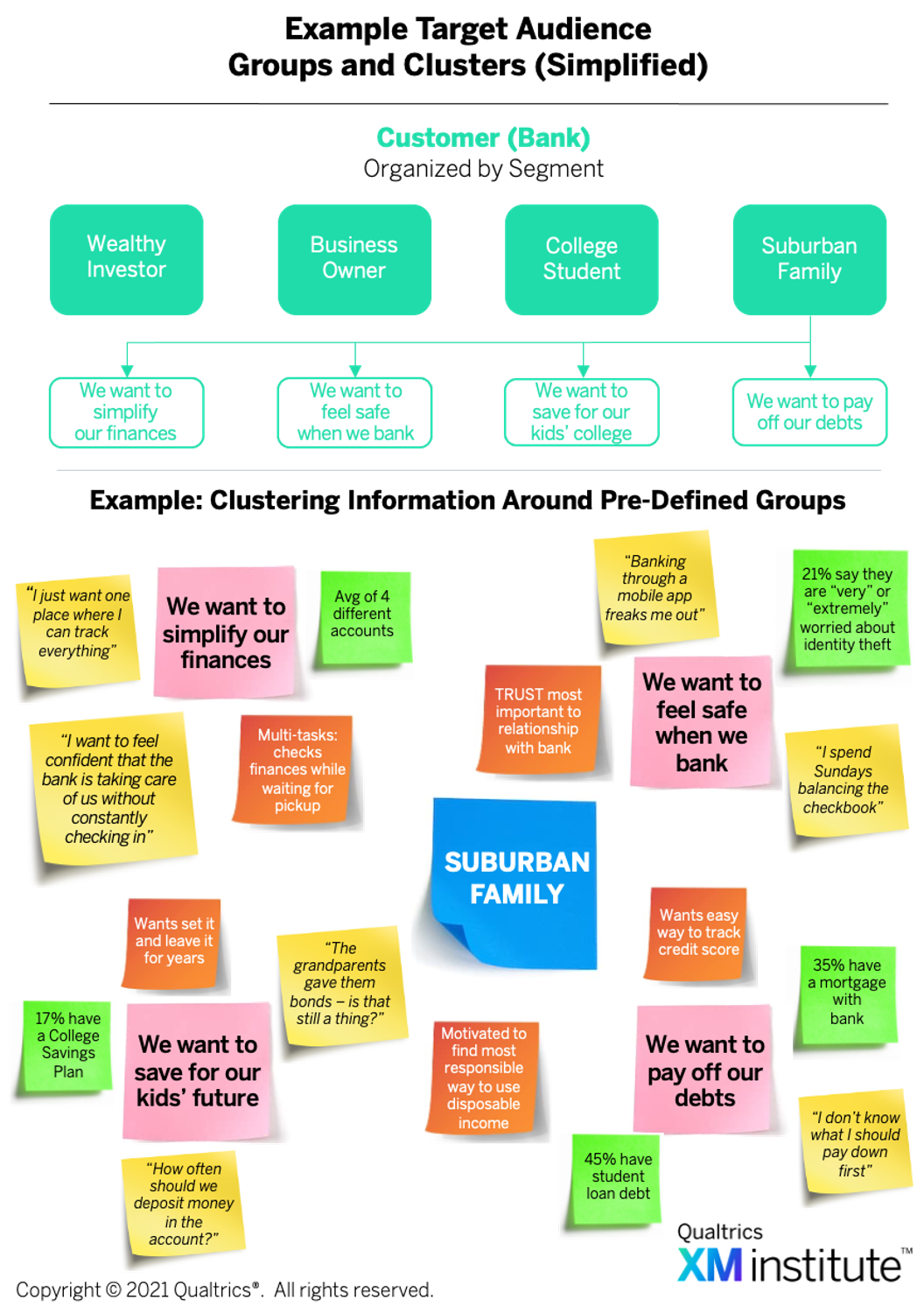 . Perhaps customers trying to purchase the same product have varying levels of familiarity with your company, or employees in the same role have different preferences for managerial styles. There are many methods you can use to identify these underlying themes and relationships, including an assimilation exercise like affinity clustering, a multivariate statistical analysis like factor analysis or cluster analysis, or rating scales where you map where people comparatively fall on key characteristics. Regardless of which method you use, at the end of this step, you should have all of your relevant research findings organized into smaller clusters underneath your broader categories.
. Perhaps customers trying to purchase the same product have varying levels of familiarity with your company, or employees in the same role have different preferences for managerial styles. There are many methods you can use to identify these underlying themes and relationships, including an assimilation exercise like affinity clustering, a multivariate statistical analysis like factor analysis or cluster analysis, or rating scales where you map where people comparatively fall on key characteristics. Regardless of which method you use, at the end of this step, you should have all of your relevant research findings organized into smaller clusters underneath your broader categories. - Create archetypal models. Based on the common characteristics within each of these clusters, you next need to synthesize an archetypal model of a person within that subgroup, which will become the source of your personas. To create these archetypes, translate your research findings within each cluster into concrete, specific details told in the form of a story. So information like, “young professional,” “68% female,” “urban,” “technologically savvy,” “first-time investor,” becomes, “Jane just graduated college from Northwestern University and recently started working as a marketing assistant at Acme Corporation in Chicago. She loves the convenience of banking through her phone, but she finds the world of investing intimidating and confusing.” These specific details should not match any single individual but should be a realistic reflection of the people in this group and the relevant attributes that distinguish them from other groups. Again, there are a range of approaches and activities you can do to translate your insights into these archetypal models – everything from creating 2×2 grids to filling out a persona worksheet – and which method you use will depend on your project and preferences
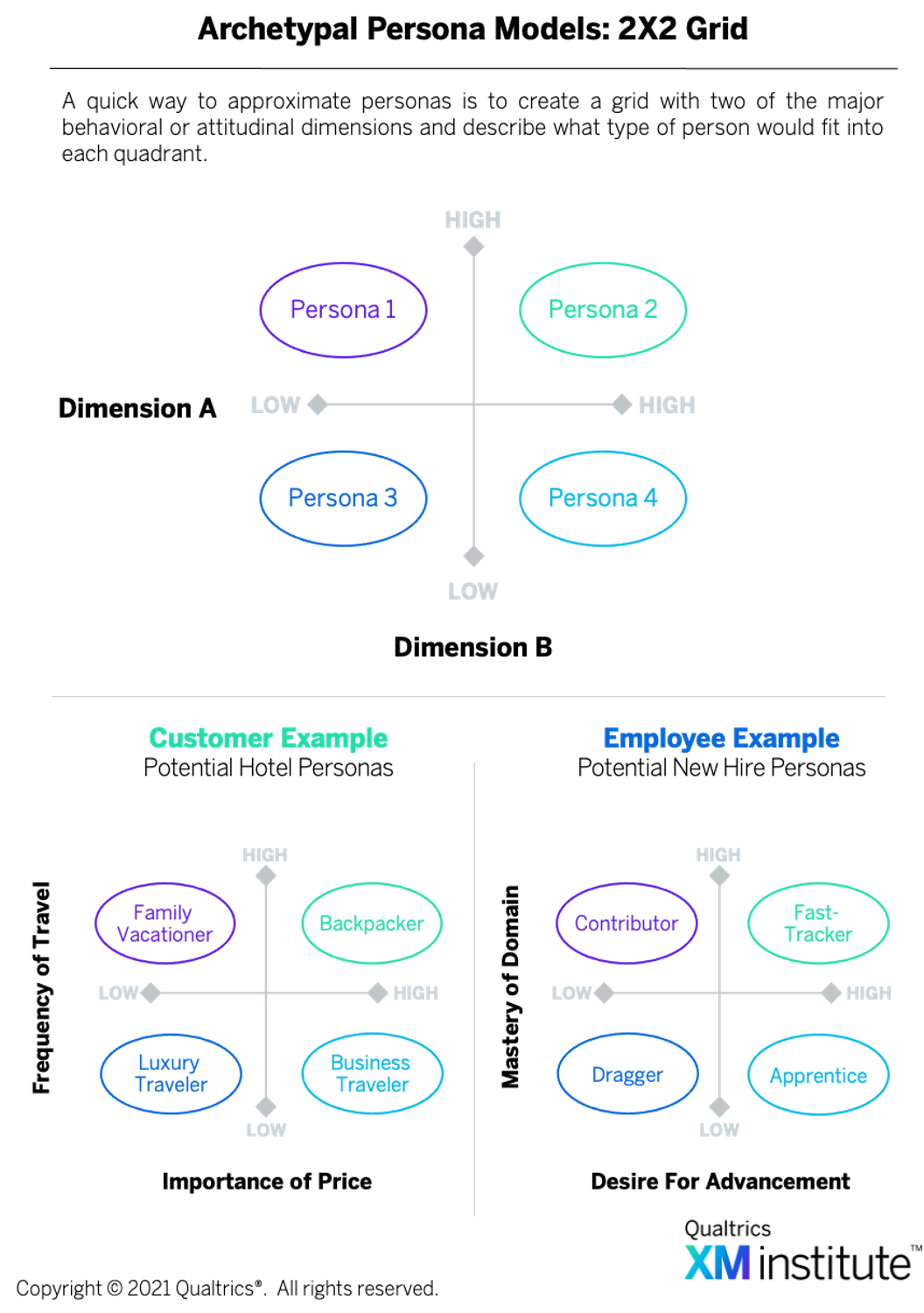
 .
.
Phase 4: Creation
Once you have translated your raw research findings into archetypal models of people within your target groups, you then need to create documentation to represent your personas. Remember, personas and persona documents are not the same thing. Personas are vivid descriptions of prototypical people within your target group, whereas persona documents – which can take many different forms – codify your personas in a form that is easy for the people using them to understand and consume. The goal of this phase is to produce a robust collection of persona documents that can be used to design and deliver better experiences to your target audience. Here are the steps you should follow within the Creation Phase:
- Prioritize and flesh out archetypes. The next step is to take the basic archetypal models you’ve created and make them more realistic and three-dimensional by giving them a face, a backstory, and a set of relevant needs, motivations, skills, pain points, and objectives. Depending on your project, you may start this step with more archetypes than you’ll ultimately turn into personas, in which case you should begin by adding just enough details – like their goals and relevant characteristics – to help you determine which would make the most valuable personas for your project’s purpose. Though the ideal number of personas may vary, a good rule of thumb is to build no more than five, with just one or two primary ones. Before you begin constructing persona documents, you may want to validate these fleshed-out archetypes with real people in that segment or SMEs familiar with the group to ensure you’ve accurately captured the average, dominant, or common characteristics that influence this audience’s experience.
- Document the representation of the persona. Once you have a set of fully-fledged personas, make them tangible and usable by cataloging their relevant attributes in a set of persona documents. There is no “correct” way to visually represent your personas, though they often take the form – at least at first – of a one-page document containing the seven elements we listed above. Templates for this document abound
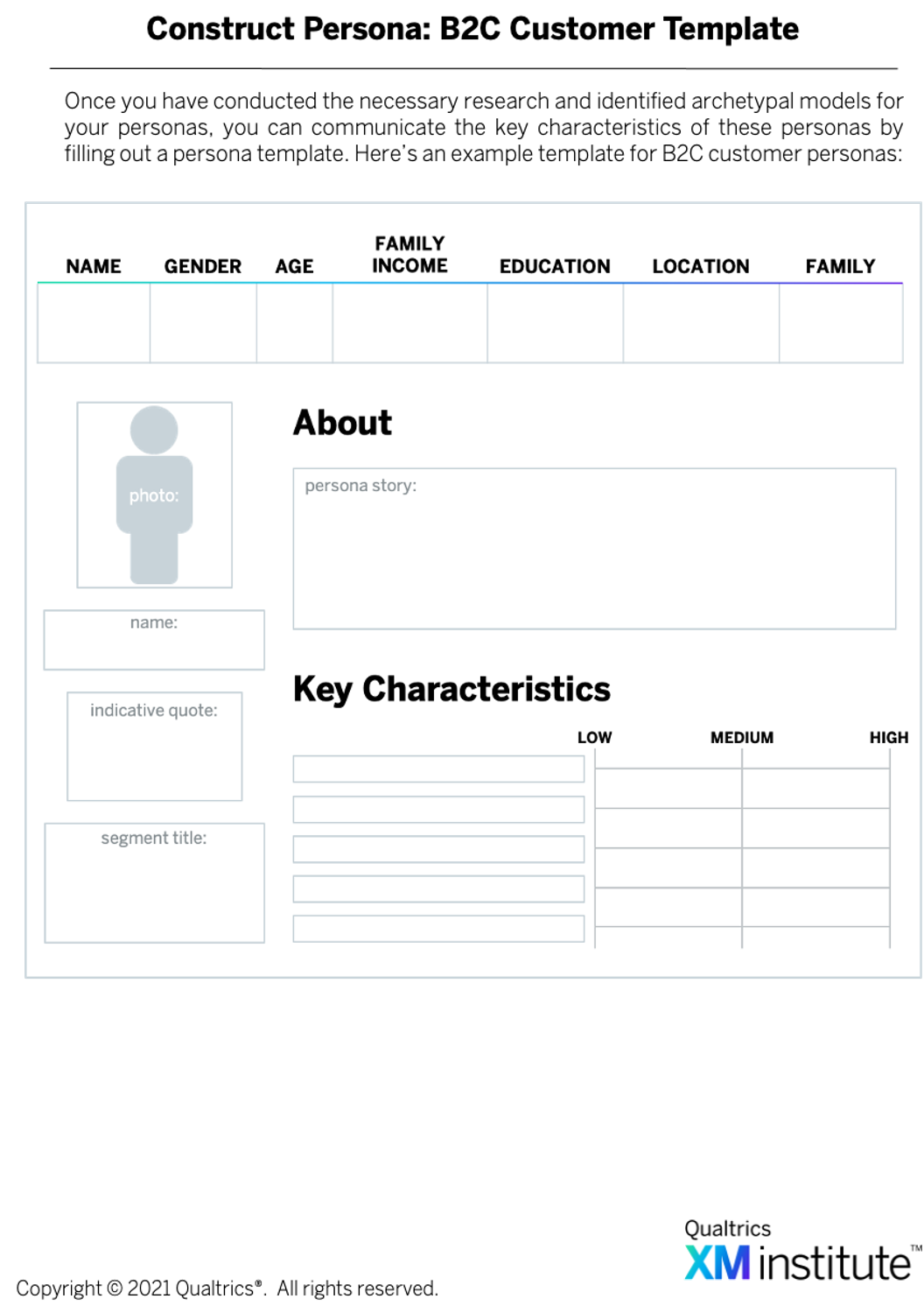
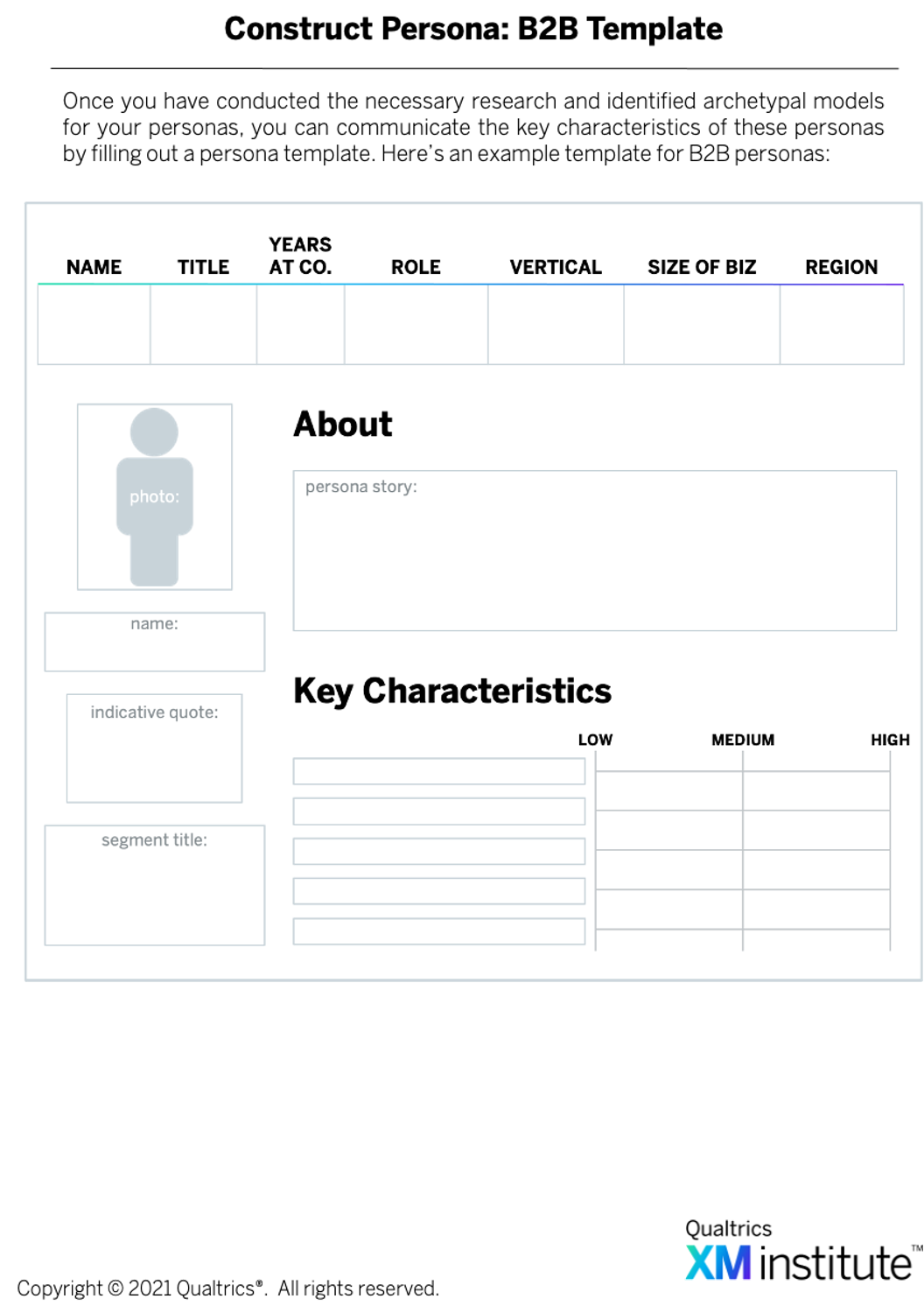
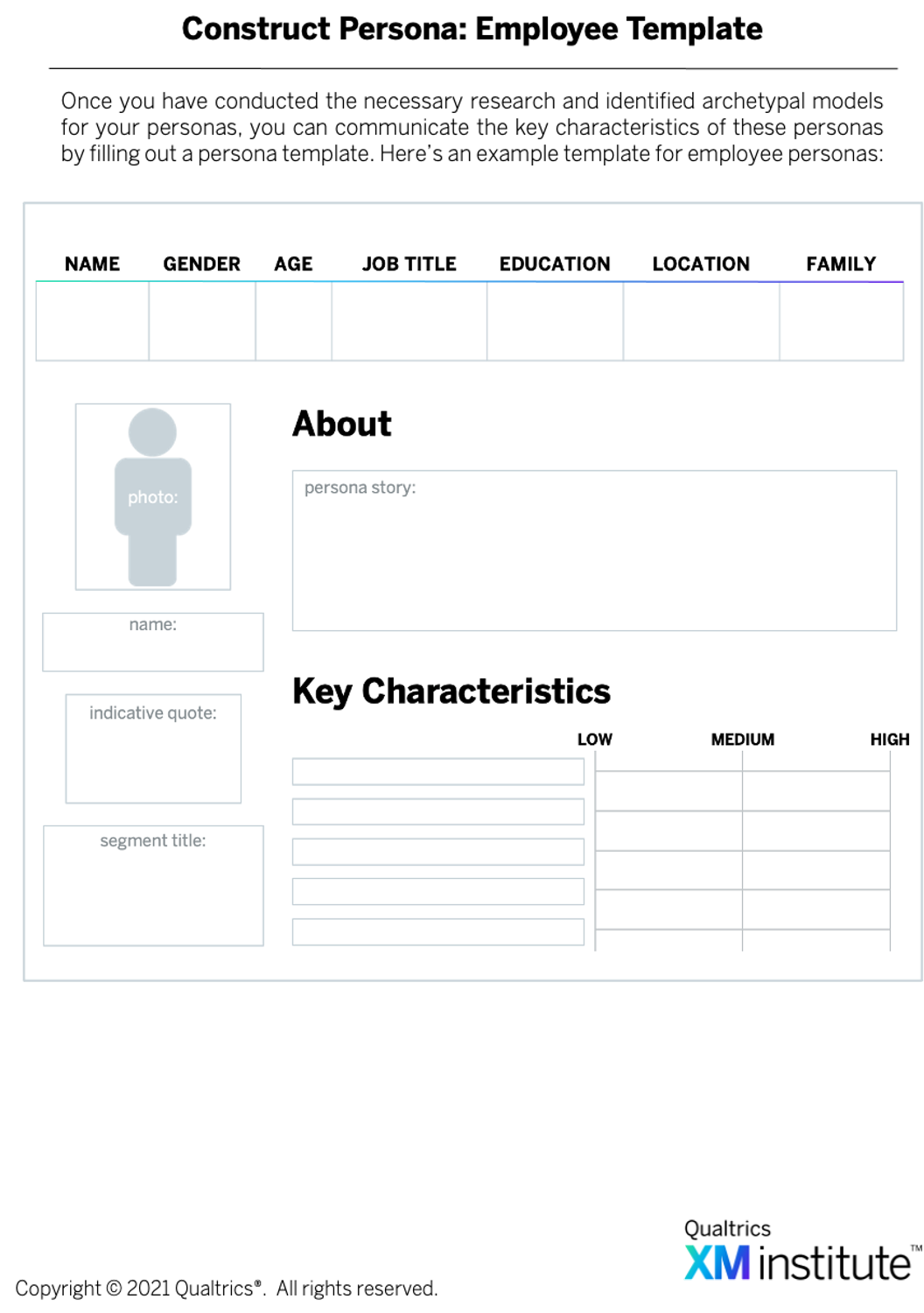 . Just make sure that whichever format you choose allows you to achieve your stated objectives and displays information in a form that is appealing, consumable, and on-brand. In addition to looking attractive, use language that generates empathy and understanding in the people who use it. However, it’s important not to bog the document down with too many details. Incorporating unnecessary minutiae will only create distractions and undermine its credibility as an analytical tool.
. Just make sure that whichever format you choose allows you to achieve your stated objectives and displays information in a form that is appealing, consumable, and on-brand. In addition to looking attractive, use language that generates empathy and understanding in the people who use it. However, it’s important not to bog the document down with too many details. Incorporating unnecessary minutiae will only create distractions and undermine its credibility as an analytical tool. - Maintain reference documents. Because persona documents are ultimately only summaries that showcase a few choice details from a much deeper, robust body of research, it’s essential to maintain comprehensive reference documents for each persona. These reference documents should house all your relevant research findings, data points, interview notes, archetype descriptions, and anything else that supports the persona. Compiling all this information in one place will give you a record of inputs and allow you to tease out more information about a particular aspect of this group later on. It will also help you justify decisions and resolve any disagreements that may arise down the line as you apply these personas to design experiences.
Phase 5: Deployment
Ultimately, the personas you create won’t provide the organization with any value unless people actually use them to improve experiences. In addition to supporting the original project they were created for, personas can also improve a number of other projects and XM efforts across the business. The more universal personas become – the more integrated they are into an organization’s vocabulary and decision-making – the more effective they will be at generating internal alignment and empathy. Here are the steps you should follow in the Deployment phase:
- Incorporate personas into other processes. Because personas are research-backed tools that communicate essential information about key audiences, the personas you create may offer value to projects beyond just their initial purpose. For example, they could be incorporated into other UX or product design processes, journey or empathy mapping, scenario review exercises, or marketing campaigns. However, since the personas are grounded in actual data, it’s important to maintain the integrity of the personas and not allow other groups to distort the information to suit their own ends. To help groups apply them appropriately, create specific instructions, guidelines, templates, tools, and procedures around how to use these artifacts. You may also choose to share your comprehensive reference documents with teams who want to dig deeper into a specific characteristic of a target group and perhaps even assign an owner for each persona who is responsible for providing guidance and managing how the persona is used.
- Socialize with appropriate audiences. In addition to supporting particular projects or processes, personas may become part of the organization’s broader efforts to become more customer- or employee-centric. This can take a number of different forms, such as leadership considering personas in strategy decisions, HR integrating them in new hire onboarding for frontline agents, insights teams applying them to shape their survey deployment strategy, or IT or implementation teams using them to influence the documentation, training, and support materials they develop. When rolling personas out to a broader swath of the organization, it’s important to follow a deliberate, controlled approach. Create and enact a clear communication plan that identifies who needs to be introduced to personas, what information each audience needs, and when and how to present that information. Regardless of the exact form these communications take – whether they’re posters hung around the office, email campaigns, or introductory videos – make sure the personas are understood and internalized by providing people with an overview of the persona method, clarifying how they help the organization achieve its broader goals, and sharing basic details about who the personas are and how to use them appropriately.
- Keep personas relevant and up-to-date. Personas are not static documents. As your business strategy, brand objectives, and target audiences shift – or as you collect more information on people within these groups – periodically update the content within the artifacts. Depending on the organizational and market dynamics, personas can have a 12-18 month shelf life between reviews. After using personas for a particular project, it is valuable to step back and evaluate how effectively they helped you design positive experiences for a target audience to determine whether they need to be updated or refined. There may also come a time when a particular persona is no longer relevant. When that time comes, it’s important to “officially” retire the persona by making a public announcement that explains why the time has come for people to stop using the character that they have come to regularly incorporate into their decision-making processes.
Common Persona Mistakes to Avoid
Here are some common mistakes to watch out for as you go through the process of building and using personas:
- Creating too many personas. The goal of personas is to help you deeply understand and cater to a select group of people. If you create too many personas, it not only dilutes the value of these tools, it might actively cause harm by leading people to design generic or disjointed experiences that don’t appeal to anyone. How many personas you create will ultimately depend on your project and organization, but three to five is usually a good target.
- Overemphasizing demographic information. Because demographic information is so readily available, people often want to fill up their personas with this type of data. However, while demographic information can provide some value during the persona development process – especially around identifying your initial target groups – over-relying on it can blind you to more relevant and meaningful characteristics, such as people’s motivations, attitudes, needs, and challenges.
- Making personas up without enough research. When people see persona templates, they are often tempted to start filling them out with their own assumptions. While this may seem like a more expedient approach, unless you’ve spent time researching the differences across target audiences, you’re likely to end up just documenting your own biases and misconceptions.
- Creating persona content that’s too complicated. While your research may unearth a number of interesting data points or pieces of trivia about people in your target groups, don’t try to cram too much information into your persona documents. Remember, you’re creating these documents to support a specific design project. If you make them too dense or add in irrelevant details, it weakens the value of the tool and may turn off potentially important users.
- Not identifying the primary persona for projects. By definition, different personas have different needs and requirements. So if you treat each persona as equally important during a design project, when their needs come into conflict, you won’t know which elements or features to prioritize. Instead, pick a primary persona you’re aiming to serve during each project. You may then also want to do secondary testing of the design with your other personas to assess how the experience works for them as well.
- Trying to map everyone into a persona. When organizations see the power of these tools, they often feel the need to map everyone into one of their personas. While this isn’t an inherently bad activity, it can lead to the development of too many personas or weaken the value of your core personas. Again, the purpose of personas is to build clarity around your target audiences, not to classify everyone. So it’s okay – or even preferable – to have a collection of personas that don’t reflect every single person who interacts with your organization.





